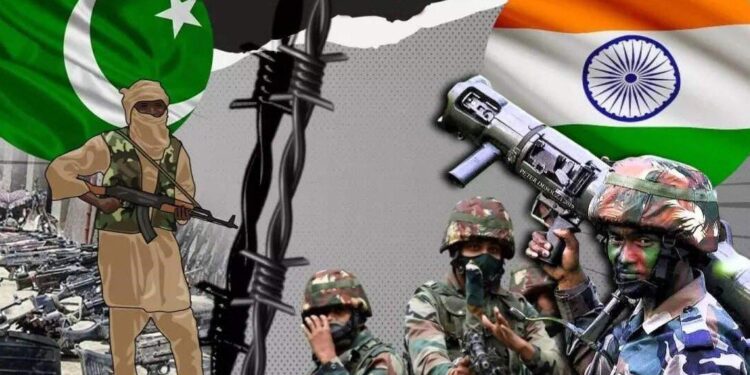India-Pakistan Conflict Escalates in a Changing World Order
As the geopolitical landscape undergoes transformative shifts, tensions between India and Pakistan have intensified, raising concerns over regional stability and global security. Recent military confrontations and diplomatic disputes reflect a volatile relationship that has persisted for decades, now further complicated by the rise of new power dynamics in Asia and beyond. Observers are closely monitoring this longstanding conflict, as both nations grapple with internal challenges and external pressures amidst a rapidly evolving world order. With China’s growing influence and the United States recalibrating its foreign policy, the stakes have never been higher. This article delves into the latest developments in the India-Pakistan conflict and explores their implications for the broader global arena.
Understanding the Geopolitical Shifts Impacting the India-Pakistan Conflict
The geopolitical landscape surrounding the India-Pakistan conflict has experienced significant realignment in recent years, influenced by a myriad of factors. Changes in global power dynamics, particularly the rise of China as a formidable ally for Pakistan, have dramatically altered the strategic calculations for both nations. With China’s increasing investment and military support, Pakistan finds itself better equipped to challenge India, complicating New Delhi’s regional dominance. In contrast, India has sought to bolster its alliances with Western powers, particularly the United States and other Quad nations, as a counterbalance to what it perceives to be an encroaching threat posed by this growing Sino-Pakistani nexus.
Additionally, emerging issues such as climate change, economic disparities, and technological advancements are further complicating traditional narratives. The impact of climate-induced crises in both countries may heighten resource disputes, especially concerning water access from shared rivers, which are essential for agriculture and livelihoods. Moreover, the ongoing technological arms race in the region, accentuated by new cyber warfare capabilities and drone technologies, could lead to miscalculations during crises. Ultimately, the intricate interplay of regional and global forces necessitates a reevaluation of strategies and diplomatic engagements for both India and Pakistan.
Assessing the Role of Regional Powers in Escalating Tensions
The complex dynamics of the India-Pakistan conflict have been significantly influenced by the roles of regional powers, each with unique interests and alliances. The increasing involvement of nations like China and the United States has led to a reconfiguration of geopolitical strategies in South Asia. China’s support for Pakistan has intensified as it sees the nation as a crucial ally in its Belt and Road Initiative, leading to increased military and economic aid. Conversely, the United States’ relationship with India has strengthened, particularly in defense collaboration aimed at countering China’s influence. This interplay not only affects bilateral relations but also shapes internal narratives within both countries, heightening nationalist sentiments that often exacerbate tensions.
Key factors underscore the delicate balance of power in this escalating conflict:
- Military Alliances: Both India and Pakistan seek to secure partnerships with regional powers to amplify their security and military capabilities.
- Economic Dependencies: Investment and economic ties with global powers can significantly sway both nations’ foreign policy decisions.
- Ideological Support: The backing of ideological allies lends legitimacy to each country’s stance in the ongoing territorial disputes.
Furthermore, recent developments indicate an increased reliance on proxy warfare and asymmetric tactics, reflecting a broader trend of regional powers leveraging these strategies to advance their interests while attempting to avoid direct confrontation.
Strategies for Diplomacy and Conflict Resolution in a New Era
In the face of rising tensions between India and Pakistan, innovative approaches to diplomacy and conflict resolution are imperative. The geopolitical landscape has transformed, necessitating a shift in traditional diplomatic strategies. Key strategies include:
- Engagement through Multilateral Forums: Utilizing platforms such as the SAARC and UN to foster dialogue can create a more inclusive environment for conflict resolution.
- Track II Diplomacy: Encouraging back-channel discussions involving non-governmental actors may uncover new perspectives and solutions that official dialogues often overlook.
- Cultural Exchange Initiatives: Promoting people-to-people interactions through cultural, educational, and sports programs can build trust and understanding between the two nations.
- Utilizing Technology: Leveraging social media and digital platforms for transparency in communication and conflict narrative can mitigate misinformation and foster a shared understanding.
Additionally, it is essential for both nations to consider economic cooperation as a pivotal component of conflict resolution. Joint economic initiatives can provide mutual benefits that may dissuade aggressive posturing. An overview of potential collaborative projects might include:
| Project | Description |
|---|---|
| Cross-border Trade Facilitation | Streamlining customs and reducing tariffs to boost bilateral trade. |
| Shared Water Resources Management | Collaborative efforts in managing rivers to address water scarcity issues. |
| Joint Renewable Energy Projects | Investing in solar and wind projects to enhance energy security for both nations. |
The Way Forward
the escalating conflict between India and Pakistan is not just a regional issue; it reflects a broader shift in the global geopolitical landscape. As both nations navigate their complex histories and national ambitions, the implications of their rivalry extend far beyond South Asia. The evolving dynamics of international alliances, economic pressures, and climate challenges add layers of complexity to an already fraught relationship. With the world watching closely, it remains crucial for global leaders to engage in diplomatic efforts that prioritize peace and stability in the region. As the situation develops, stakeholders on both sides must grapple with the necessity for dialogue and cooperation in an increasingly interconnected world. The future of Indo-Pak relations—and indeed, regional and global security—may well depend on the ability to adapt to these changing realities.































